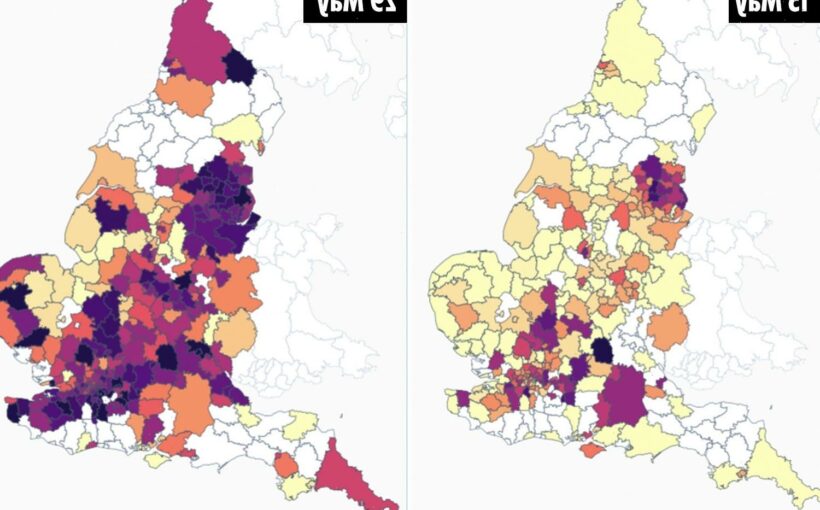MAPS reveal how quickly the super infectious Delta (Indian) variant spread to all corners of the country.
In just two weeks, the strain went from a proportion of 38 per cent to 75 per cent, making it dominant in England.
🔵 Read our coronavirus live blog for the latest updates
The data from the Welcome Sanger Institute shows how fast the variant has managed to grip the UK, having only been detected for the first time on April 10.
It's reminiscent of the Alpha (Kent) strain which caused havoc at the end of 2020 when it soared to dominance in a matter of weeks, throwing England into the third lockdown.
The data comes amid growing pressure to delay the June 21 unlocking in England.
The Delta variant is driving the rise in Covid cases, alongside lifting of restrictions.
Experts have said it is now evident the UK is at the start of a third wave and things would only escalate if June 12 went ahead.
Not only is the Delta variant (B.1.617.2) faster spreading by around 40 per cent, but there is now evidence that it causes more severe disease.
But rising cases is yet to be mirrored by increasing hospital cases, however, with the latest data showing patient numbers have climbed slightly.
The NHS is in a race to double jab the vulnerable as fast as possible given that one jab is not considered protective enough.
But some Tory MPs are fighting against “moving goalposts” for the opening of society due to the damage it will have on businesses.
There are reports the PM is considering holding back by just two weeks to allow more time for vaccinations, with a decision imminent.
Rapid spread
Data from the Sanger Insitute – which tracks Covid variants – shows that in the fortnight to May 15, the Delta variant had already become dominant in no more than 50 areas.
Fast-forward to May 29 – the most recent date available – the Indian variant has become dominant in at least 150 areas.
Dominance means that of all Covid cases sequenced, B.1.617.2 is making up at least half.
On May 15 the “hotspots” were visible and centred in the North West. Parts of the South West and South East, including London, were also more affected.
But now there is a sea of dominance in the Midlands, with hotspots including Derby and Leicester.
Delta has spread throughout the South East, now dominant in the majority of London boroughs, through to Kent and some parts of Essex.
Only parts of the South coast spared, such as Brighton.
The North West region has become completely overthrown by the variant, having had hotspots of Bolton and Blackburn with Darwen for a few weeks.
The maps also show the Delta variant spread quite rapidly to the East of England in one fortnight.
And parts of the South West are also facing a growing epidemic, including Cornwall and North Somerset.
Where are the hotspots?
Hotspots by case number
How many cases of the Indian variant were detected per week in the two weeks to May 29:
Bolton: 837
Blackburn with Darwen: 406
Manchester: 246
Birmingham: 200
Leicester: 152
Bedford: 226
Hotspots by dominance
Areas where the Delta variant made up more than 90 per cent of cases in the two weeks to May 29:
Blackburn with Darwen
Bolton
Ribble Valley
Pendle
Calderdale
Rossendale
West Lancashire
Wirral
Newcastle-under-Lyme
West Lindsey
Dover
Canterbury
Tonbridge and Malling
Sevenoaks
Castle Point
Mole Valley
Reigate and Banstead
Spelthorne
Surrey Heath
Bracknell Forest
South Bucks
Croydon
Richmond-upon-Thames
Kingston-upon-Thames
East Hertfordshire
Central Bedfordshire
Bedford
West Oxfordshire
East Northamptonshire
Cheltenham
Tewkesbury
Babergh
South Norfolk
Great Yarmouth
Nuneaton and Bedworth
Charnwood
Litchfield
The variant is becoming dominant in growing parts of the North East and Yorkshire, but some areas remain untouched.
Just because the variant is dominant in an area does not necessarily mean cases are high.
For example, an area could be under 100 per cent dominance by the Delta strain but had only seen three Covid cases that week.
Looking at case numbers, Bolton and Blackburn with Darwen had several hundred cases more than any other part of England.
Bedford, Birmingham, Manchester and Leicester also recorded between 150 and 250 cases per week in the fortnight to May 29.
National picture
It comes as separate data from the Government reveals nearly three-quarters of local areas of the UK are seeing rising Covid rates.
Analysis by PA shows that 283 out of 380 areas recorded a week-on-week increase for the week to June 2.
This is the highest proportion since January 6.
In just under half of these places (134), the rise was small enough to be in single figures.
But a growing number of areas are recording sharp jumps in rates, some of them large enough to push them above the symbolic level of 100 cases per 100,000 people.
Now 28 local authorities are recording rates above 100 cases per 100,000 – the highest number since March 28.
Blackburn with Darwen in Lancashire continues to record the highest rate in the UK, with 515.7 cases per 100,000 people (up from 390.8 a week earlier).
Data published on Friday by the Office for National Statistics (ONS) suggest infection levels are now rising more generally in England.
Around one in 640 people in private households were estimated to have had Covid in the week to May 29 – up from one in 1,120 in the previous week.
Source: Read Full Article





